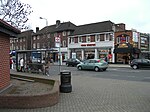William Girling Reservoir
AC with 0 elementsDrinking water reservoirs in EnglandReservoirs in LondonSites of Special Scientific Interest in LondonThames Water reservoirs

The William Girling Reservoir is located in the London Borough of Enfield and is part of the Lee Valley Reservoir Chain that supplies London with drinking water. It is named after William Girling OBE, a chairman of the Metropolitan Water Board (MWB). The reservoir and the nearby King George V Reservoir are known collectively as the Chingford Reservoirs. The storage reservoir, which is owned by Thames Water, is bordered by Chingford to the east and Ponders End and Edmonton to the west, and covers 334 acres (135 hectares) with a perimeter of 3.5 miles (5.6 km). There is no public access.
Excerpt from the Wikipedia article William Girling Reservoir (License: CC BY-SA 3.0, Authors, Images).William Girling Reservoir
Waltham Way, London Chingford (London Borough of Waltham Forest)
Geographical coordinates (GPS) Address Nearby Places Show on map
Geographical coordinates (GPS)
| Latitude | Longitude |
|---|---|
| N 51.6316 ° | E -0.0244 ° |
Address
Waltham Way
Waltham Way
E4 7SR London, Chingford (London Borough of Waltham Forest)
England, United Kingdom
Open on Google Maps








